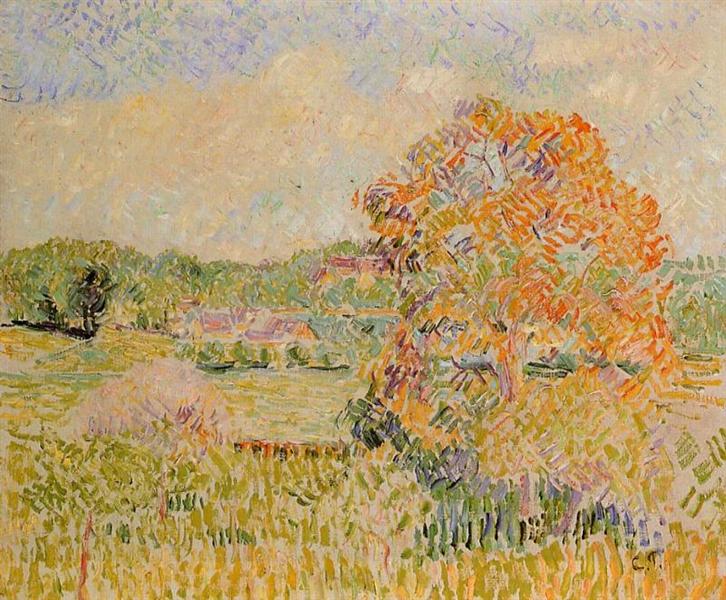תיאור
The painting "Spring at Eragny (Study)" from 1890, by the notable Impressionist Camille Pissarro, stands as a testament to the vivacity and richness of the first seasons of the year, encapsulating an ephemeral experience and an intimate connection between humans and nature. In this canvas, Pissarro invites us to immerse ourselves in a rural landscape that seems to breathe and vibrate with the soft, enveloping light of spring.
From a compositional perspective, the work exhibits a delicate balance between natural elements and pictorial space. The canvas is constructed in a way that leads the viewer to follow the visual path of the flowering trees that dominate the scene, framing a background where vegetation unfolds generously. Pissarro's characteristic technique, with loose brushstrokes and an almost instantaneous capture of light, allows the landscape to be presented as a moment frozen in time. Through a masterful use of light and color, the artist creates an environment that seems to pulse with the heartbeat of life itself.
The colour palette is another aspect worth mentioning. Pissarro opts for a sophisticated use of green, yellow and pink hues that bring the scene to life. The use of light reflects the imminent arrival of the blossoming spring, conveying a sense of freshness and vitality. This vibrant palette is accompanied by a subtle play of shadows that accentuates the volume and dimensionality of the elements, reinforcing a sense of immersion in the work.
Although there are no predominant human figures in this composition, there are hints of everyday life, characteristic of the rural lifestyle that Pissarro often observed in Eragny, his home at the time. Trees and hills are the undisputed protagonists, opening a dialogue between the artist and the landscape that surrounds him. This lack of human figures can be interpreted as an invitation for the viewer to become part of the environment, promoting a reflection on the harmony between humanity and nature.
The approach to Impressionism that Pissarro adopted in this work is representative of an artistic movement that focused on capturing light and color in their most fleeting moments. Through this piece, Pissarro aligns himself with his contemporaries, such as Claude Monet and Pierre-Auguste Renoir, who also explored the relationship between the natural environment and the moment of perception. However, Pissarro's particular style, which often emphasized social aspects and rural life, gave him a distinctive approach that makes him a pioneer in the representation of everyday life within Impressionism.
In conclusion, “Spring at Eragny (Study)” is not only a visual exploration of the vibrant metamorphosis of the season, but also a reflection on the interactions between humans and their environment. The work invites the viewer to experience the fleeting beauty of spring and to consider the subtle complexity of the relationships that form within it. In every brushstroke, Pissarro leaves a legacy that not only celebrates nature, but also reminds us of the importance of living with it in its most beautiful and ephemeral moments.
KUADROS ©, a famous painting on your wall.
Hand-made oil painting reproductions, with the quality of professional artists and the distinctive seal of KUADROS ©.
Painting reproduction service with satisfaction guarantee. If you are not completely satisfied with the replica of your painting, we will refund 100% of your money.

